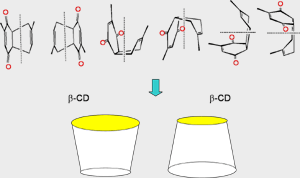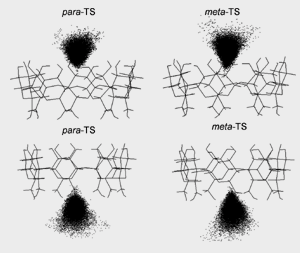
Molecular Recognition in Cyclodextrin Chemistry
Factors controlling the structure and selectivity of this classic host are studied. By improving current knowledge about cyclodextrin, we hope to bring rational modification of cyclodextrin into realization.
----Revelation of site of selectivity and the importance of shallow binding----
 Multiple binding configurations of CD•TS (TS=meta-TS and para-TS) at top and bottom rims are considered.
Multiple binding configurations of CD•TS (TS=meta-TS and para-TS) at top and bottom rims are considered.
- Using bimolecular CD•TS complex (β-cyclodextrin complexed with a Diels-Alder transition structure) as models in molecular dynamics simulations has enabled us to gain insights into the controlling factors in this CD-mediated Diels-Alder reaction of methyl-p-benzoquinone with isoprene.
- Simulations showed regioselectivity is achieved through shallow binding and multiple binding geometries are possible.
- The narrower bottom rim of β-CD shows higher regioisomer discrimination than the wider top rim.
 Dot plot diagrams showing the area sampled by the TS around the top and bottom rims of β-CD (each dot represents the center of mass of TS relative to β-CD)
Dot plot diagrams showing the area sampled by the TS around the top and bottom rims of β-CD (each dot represents the center of mass of TS relative to β-CD)
- Li, W.-S.; Chung, W.-S.; Chao, I. Chem. Eur. J. 2003, 9, 951-962.
- Chu, J.-H.; Li, W.-S.; Chao, I.; Chung, W.-S. Tetrahedron 2004, 60, 9493-9501.
- 電荷誘導之分子內電荷轉移及其應用
- 有機半導體之電荷傳導性質
- 超分子化學、分子辨識與自組裝排列
- 分子結構與化學反應機構